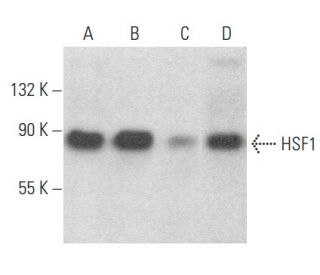
HSF1 항체(E-4): sc-17757. MCF7 (A), MDA-MB-231 (B), A2058 (C) 및 K-562 (D) 전체 세포 용해물에서 HSF1 발현의 웨스턴 블롯 분석.
HSF1 항체 (E-4): sc-17757
- HSF1 항체 E-4 는 마우스 monoclonal IgG1 κ HSF1 항체, 51간행물에 인용, 이며 200 µg/ml으로 제공합니다.
- human origin의 heat shock transcription factor 1 (HSF1)에서 내부에 위치한 219-529 아미노산을 항원으로 사용하였습니다.
- HSF1 항체 (E-4)는 WB, IP, IF, IHC(P) and ELISA으로 mouse, rat and human유래의 HSF1 를 감지하는 데에 추천한다.
- 항-HSF1 항체(E-4)는 IP용 agarose와 결합되어 이용 가능하며, WB, IHC(P), ELISA용 HRP와 결합되어 이용 가능하며, IF, IHC(P), FCM용 phycoerythrin 또는 FITC와 결합되어 이용 가능합니다.
- WB (RGB), IF, IHC(P) 와FCM, RGB fluorescent imaging systems, such as iBright™ FL1000, FluorChem™, Typhoon, Azure and other comparable systems에 사용가능한 Alexa Fluor® 488, Alexa Fluor® 546, Alexa Fluor® 594 or Alexa Fluor® 647결합제품도 있습니다.
- WB (NIR), IF와FCM,Near-Infrared (NIR) detection systems, such as LI-COR®Odyssey®, iBright™ FL1000, FluorChem™, Typhoon, Azure and other comparable systems에 사용가능한 Alexa Fluor® 680 or Alexa Fluor® 790 결합제품도 있습니다.
- Gel Supershift와 ChIP 에 사용하는 TransCruz시약(sc-17757 X, 200 µg/0.1 ml)이 있습니다.
- m-IgGκ BP-HRP는 HSF1 항체 (E-4) WB 및 IHC(P) 애플리케이션용입니다. 이 시약은 현재 HSF1 항체 (E-4)(아래 주문 정보 참조)와 함께 번들로 제공됩니다. 추가 m-IgGκ BP 접합체는 마우스 IgG 결합 단백질 전체 목록을 참조하세요.
빠른 링크
보조 제품
설명
Gene 정보
프로틴 시퀀스
데이터 시트 및 프로토콜
연구 정보
HSF1 항체(E-4)는 마우스, 쥐, 인간에서 유래된 HSF1을 웨스턴 블롯(WB), 면역침전(IP), 면역형광(IF), 면역조직화학(IHC), 효소결합 면역흡착 분석법(ELISA)을 통해 검출하는 마우스 단일클론 IgG1 카파 경쇄 항체입니다. HSF1 단일 클론 항체(E-4)는 비접합 형태와 아가로스, 호스래디시 퍼옥시다아제, 피코에리트린, 플루오레세인 이소티오시아네이트, 다중 알렉사 플루오르® 접합체를 포함한 다양한 접합체 형태로 제공됩니다. HSF1은 세포를 손상으로부터 보호하는 데 도움이 되는 열 충격 단백질의 발현을 조절함으로써 스트레스, 특히 열 및 화학적 스트레스에 대한 세포 반응에 중요한 역할을 합니다. 이러한 조절은 세포의 항상성을 유지하고 불리한 조건에서 세포 생존을 촉진하는 데 필수적입니다. HSF1은 일반적으로 단량체로 존재하지만, 활성화되면 핵으로 이동하는 삼량체를 형성하여 HSF1이 표적 유전자의 프로모터 영역에 있는 열 충격 요소에 결합하여 전사를 촉진합니다. HSF1은 에스트로겐에 의해 상향 조절되어 mRNA 및 단백질 수준에서 활성을 향상시키며, 이는 세포 스트레스 반응의 중요성과 스트레스 및 염증과 관련된 질병에 대한 잠재적 영향을 더욱 강조합니다.
연구용으로만 사용가능합니다. 진단이나 치료용으로 사용불가합니다.
Alexa Fluor®는 미국 오리건주 Molecular Probes Inc.의 상표입니다.
LI-COR®와 Odyssey®는 LI-COR Biosciences의 등록 상표입니다.
HSF1 항체 (E-4) 참고문헌:
- 진핵생물에서 열충격 유전자의 전사적 활성화. | Tanguay, RM. 1988. Biochem Cell Biol. 66: 584-93. PMID: 3048332
- 악성 변형에서 HSF1 단백질의 역할. | Šimončík, O., et al. 2018. Klin Onkol. 31: 55-62. PMID: 31023025
- 종양 미세환경에서 HSF1과 샤페론 네트워크의 역할. | Grunberg, N., et al. 2020. Adv Exp Med Biol. 1243: 101-111. PMID: 32297214
- HSF1은 간세포암에서 APOJ/STAT3 매개 PD-L1 발현을 조절함으로써 면역치료 반응에 관여한다. | Cheng, H., et al. 2023. Cancer Biol Ther. 24: 1-9. PMID: 36482717
- 열 충격 인자 1(HSF1)은 표준 열 충격 반응과 관계없이 c-MYC 매개 전사를 강화합니다. | Xu, M., et al. 2023. Cell Rep. 42: 112557. PMID: 37224019
- 열 충격 유발 자극에 대한 암세포의 전사적 반응은 강력한 HSF1 결합의 증폭을 포함합니다. | Dastidar, SG., et al. 2023. Nat Commun. 14: 7420. PMID: 37973875
- 열충격 전사인자의 에스트로겐 의존적 발현: 열충격 단백질의 자궁 합성에 대한 시사점. | Yang, X., et al. 1995. J Steroid Biochem Mol Biol. 52: 415-9. PMID: 7748806
- 주사력 현미경을 이용한 고리형 DNA 복합체에서 열충격 전사인자 2 화학량론 측정. | Wyman, C., et al. 1995. EMBO J. 14: 117-23. PMID: 7828583
- 마우스 배아 발생 중 열충격 인자 2의 기능 및 조절. | Rallu, M., et al. 1997. Proc Natl Acad Sci U S A. 94: 2392-7. PMID: 9122205
- 열충격 반응 및 단백질 분해: 유비퀴틴-프로테아좀 경로에 의한 HSF2의 조절. | Mathew, A., et al. 1998. Mol Cell Biol. 18: 5091-8. PMID: 9710593
- 프로테아좀 억제는 열충격 인자 계열의 모든 구성원의 활성화로 이어집니다. | Kawazoe, Y., et al. 1998. Eur J Biochem. 255: 356-62. PMID: 9716376
- 글리코겐 합성 효소 키나제 3베타와 세포 외 신호 조절 키나제는 열충격 후 전사 활성 과립의 소멸을 촉진하여 열충격 전사인자 1을 비활성화합니다. | He, B., et al. 1998. Mol Cell Biol. 18: 6624-33. PMID: 9774677
주문정보
| 제품명 | 카탈로그 번호 | 단위 | 가격 | 수량 | 관심품목 | |
HSF1 항체 (E-4) | sc-17757 | 200 µg/ml | RMB2377.00 | |||
HSF1 (E-4): m-IgGκ BP-HRP 번들 | sc-551063 | 200 µg Ab; 40 µg BP | RMB2662.00 | |||
HSF1 항체 (E-4) X | sc-17757 X | 200 µg/0.1 ml | RMB2377.00 | |||
HSF1 항체 (E-4) AC | sc-17757 AC | 500 µg/ml, 25% agarose | RMB3129.00 | |||
HSF1 항체 (E-4) HRP | sc-17757 HRP | 200 µg/ml | RMB2377.00 | |||
HSF1 항체 (E-4) FITC | sc-17757 FITC | 200 µg/ml | RMB2482.00 | |||
HSF1 항체 (E-4) PE | sc-17757 PE | 200 µg/ml | RMB2580.00 | |||
HSF1 항체 (E-4) Alexa Fluor® 488 | sc-17757 AF488 | 200 µg/ml | RMB2685.00 | |||
HSF1 항체 (E-4) Alexa Fluor® 546 | sc-17757 AF546 | 200 µg/ml | RMB2685.00 | |||
HSF1 항체 (E-4) Alexa Fluor® 594 | sc-17757 AF594 | 200 µg/ml | RMB2685.00 | |||
HSF1 항체 (E-4) Alexa Fluor® 647 | sc-17757 AF647 | 200 µg/ml | RMB2685.00 | |||
HSF1 항체 (E-4) Alexa Fluor® 680 | sc-17757 AF680 | 200 µg/ml | RMB2685.00 | |||
HSF1 항체 (E-4) Alexa Fluor® 790 | sc-17757 AF790 | 200 µg/ml | RMB2685.00 |
